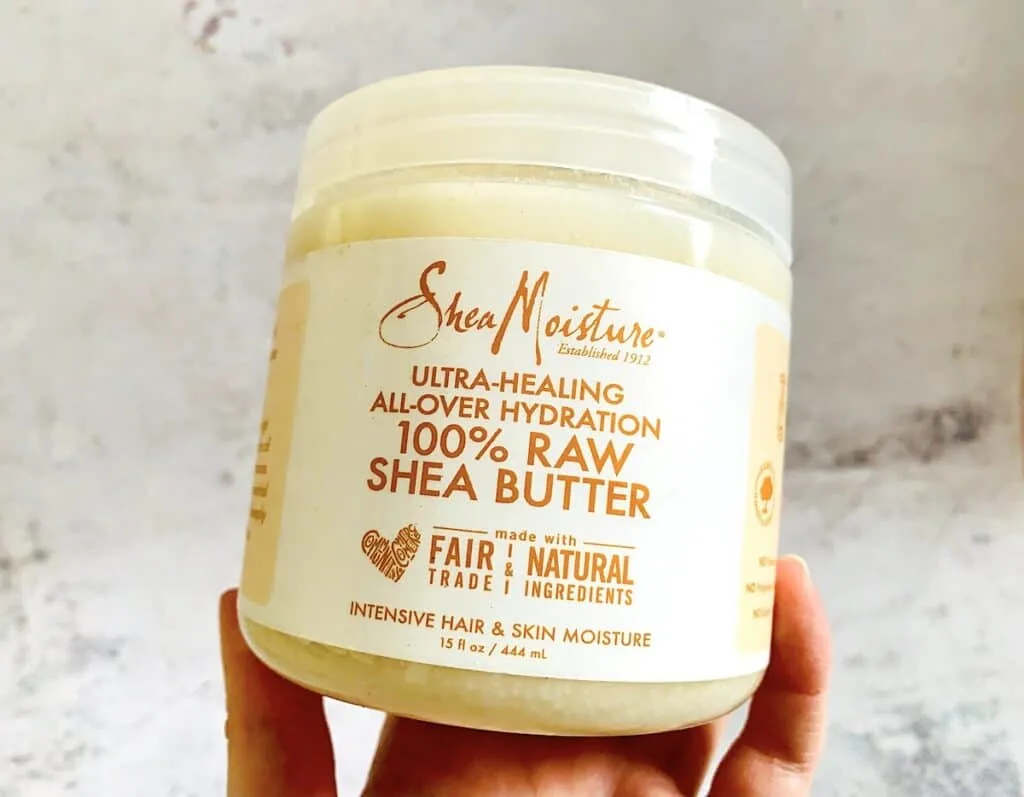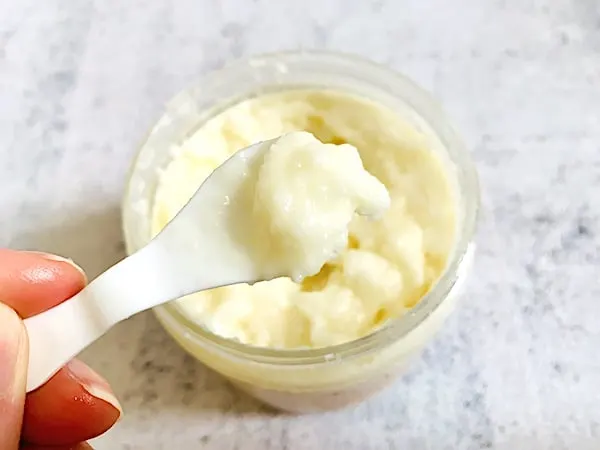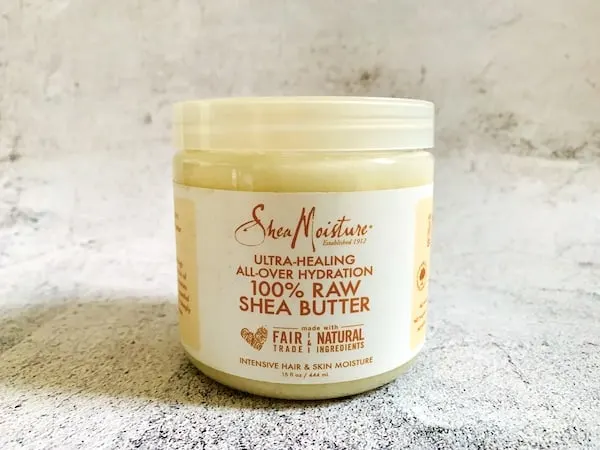Shea butter feels amazing on the skin, especially on your face, when you’re looking to add a little moisture, elasticity, and “bounce.” But is this skincare ingredient safe to use? Is shea butter comedogenic? Is it going to cause you to breakout?

We’ll cover that (and more) in this detailed guide on shea butter, including its comedogenic level and its benefits for your skin.
This post contains affiliate links, and any purchases made through these links will result in a commission for me at no extra cost to you. Please read my Disclosure for additional information.
Jump Ahead To:
Is Shea Butter Comedogenic?

There hasn’t been an official designation from the FDA, the pharmaceutical industry in general, or even the skincare world at large as to whether or not shea butter should be considered comedogenic or non-comedogenic.
Yes, you’re reading that right: the official designation for shea butter and its comedogenicity is still a little bit up in the air!
Some people say that shea butter is perfectly fine to use on your skin and that it melts and then is rapidly absorbed into your skin and isn’t ever going to run the risk of clogging your pores or causing blemishes along the way.
Other folks, though, aren’t so convinced.
They think that something as thick and as rich as shea butter, even if it has a whole bunch of other health-boosting properties, has the potential to be comedogenic and cause breakouts for sure.
Truth be told, the reality is probably somewhere in the middle, because your skin will react differently to shea butter depending on your skin type and unique complexion.
Comedogenic = Clogged Pores
You’d think that with the incredible popularity of shea butter as a skincare product, you wouldn’t ever have to worry about it causing acne, causing blackheads, or causing breakouts to happen, which is what we mean when we use the word comedogenic.
At the same time, anyone that has rubbed a bit of shea butter between their hands before applying it to their skin knows that it isn’t exactly the thinnest substance in the world.
The texture and consistency of shea butter are a little bit on the thicker side of things. There’s a reason that they call it “butter,” after all!
The Comedogenic Scale
The comedogenic scale measures how likely it is that a particular ingredient will clog your pores and cause blemishes in the process.
It all depends on the chemical profile of a substance and how it reacts with your skin.
The comedogenicity scale ranges from 0 to 5, with 0 being non-comedogenic (won’t clog pores) and 5 being highly comedogenic (will clog pores).
The more comedogenic an ingredient and the higher rating it has, the more likely it is to be a problem and cause breakouts.
Keep in mind that pure shea butter will have a different effect than a skincare product that only contains a small amount of shea butter.
Drawbacks of The Comedogenic Scale
The comedogenic scale itself has some drawbacks.
The comedogenic scale was created in the 1970s and rated the comedogenic responses of animals (rabbit ears). While skin reactions may be similar, humans are not rabbits.
Also, the scale is not standardized, so there is no uniform way to measure the comedogenic levels of a substance. Human trials and testing of comedogenicity in skincare ingredients are ongoing.
Shea Butter’s Comedogenic Rating
Shea butter is considered low on the comedogenic scale, coming in between 0 and 2. This low rating makes it a better choice than several other popular emollients, butters, and oils.
However, you should still exercise caution if you have combination skin, oily skin, or acne-prone skin due to shea butter’s relatively thick consistency and fatty acid content.
Comedogenic Ratings of Other Skincare Oils and Butters
Highly comedogenic oils and butters include:
- cocoa butter
- coconut oil
- wheat germ oil
- palm oil
- soybean oil
Low or non-comedogenic oils include:
- sea buckthorn oil
- argan oil
- safflower oil
- rosehip oil
- hemp seed oil
- meadowfoam seed oil
- abyssinian seed oil
- grapeseed oil
Chemical Composition of Shea Butter
Shea butter’s chemical composition is made up of the following essential fatty acid profile: oleic acid (approx 47%) and stearic acid (approx 43%) and smaller amounts of palmitic acid and linoleic acid.
Oleic acid, an omega-9 fatty acid, has anti-inflammatory benefits is ideal for dry skin types, but may clog pores.
Linoleic acid is an essential fatty acid that is an important part of this discussion because acne patients have been shown to have low levels of linoleic acid in their skin.
Unfortunately, shea butter only contains around 5-7% linoleic acid, so for acne-prone skin, shea butter will probably clog your pores and worsen acne and breakouts.
Shea Butter and Skin Type
For some folks, the answer to “is shea butter comedogenic” will be a resounding no. They will be able to use this product on their skin all the time without any fear of breakouts.
If you have dry skin that is not sensitive or acne-prone, there is a good chance that you will fall into this category.
For other folks, like those with acne-prone and oily skin and especially those with particularly sensitive skin, even a skincare ingredient as beneficial as shea butter should only be used very sparingly. The potential for it to clog your pores (especially on your face) is more likely.
Even with its low comedogenic rating, The American Academy of Dermatology notes that shea butter has the potential to clog pores. So you can see why the verdict is out on this skincare ingredient when it comes to comedogenicity.
Regardless of whether or not you use shea butter on your skin, as with any new skincare product, your best bet would be to patch test shea butter before using it on your skin for the first time.
Benefits of Shea Butter for Your Skin
The myriad of benefits that shea butter brings to the table for your skin is a big part of why it’s so popular in the skincare world at large.
For one thing, this skincare superstar has a tremendous amount of valuable fatty acids, essential vitamins and minerals, and a whole host of beneficial properties it releases upon contact with your skin that can’t be ignored.
On top of that, there are very few real side effects to using shea butter on your skin (even over the long haul).
Let’s run through a couple of the most important benefits this product offers if you’re thinking about using it to boost and refresh your skin.
Moisturizing Properties
Shea butter is rich in vitamins A, E, and F and other nutrients that help to give it natural moisturizing properties.
Shea butter absorbs into your skin, allowing all of the moisture to penetrate deeper into the individual layers of your skin. It’s not just going to sit on the surface but is instead going to penetrate to provide you with all of the health-boosting properties you’re after.
Those with dry skin will most likely find shea butter very soothing and beneficial for their skin type as it can help strengthen and restore their skin barrier.
Anti-Inflammatory Properties
On top of moisturizing your skin, shea butter also fights against inflammation. Shea butter has been shown to offer anti-inflammatory benefits for the skin, which can help with skin sensitivity, itching, and conditions like eczema.
If you’re dealing with a lot of redness, or have dry, itchy, irritated skin that just won’t go away, then shea butter has the potential to be a game-changer for your skincare routine.
Anti-Aging Properties
Shea butter contains antioxidants that can help fight free radicals that damage your skin cells.
Free radicals wreak havoc on the cells in your skin, which can accelerate the aging process and cause wrinkles and fine lines to appear as well as hyperpigmentation, dark spots, dullness and discoloration.
Some claim that shea butter supports collagen production, which can help with skin elasticity, firmness, and skin tone.
Potential Risk Factors and Side Effects of Shea Butter
The potential risk factors with shea butter are minimal, but some people may have sensitivities to the tree nut proteins in shea butter, so it is always important to patch test before applying shea butter to your skin for the first time.
Shea Moisture 100% Raw Shea Butter

Shea Moisture 100% Raw Shea Butter is certified organic and ethically sourced from women’s cooperatives in Northern Ghana.
Rich in vitamins and essential fatty acids, this raw shea butter soothes irritated skin, moisturizes, and softens dry, cracked skin and chapped lips.
It also can be used on your hair, as it calms dry, irritated scalps, conditions your strands, protects your hair from heat, and softens your hair.
You only need a small amount, as this organic shea butter melts in the warmth of your skin. It has a very mild scent, is cruelty-free, and contains only Certified Organic Butyrospermum Parkii (Shea) Butter.
Raw Unrefined Shea Butter vs Refined Shea Butter
Raw, unrefined shea butter has not been processed at all. It has a nutty, earthy smell and a cream or yellow shade.
This type of shea butter has not been filtered to remove all impurities and retains all its nutrients, antioxidants, and phytochemicals, and its benefits remain intact.
Refined shea butter has been refined, bleached, and deodorized. The refining process can take away some of the beneficial and replenishing properties of shea butter.
The Bottom Line on Shea Butter and Clogged Pores
Is shea butter comedogenic, and does shea butter clog pores?
The answer is that it depends. Unfortunately, there is no clear-cut answer, as everyone’s skin will react differently to shea butter.
If you have oily or acne-prone skin, you may want to choose a more lightweight moisturizer or low comedogenic oil like rosehip oil which contains higher levels of linoleic acid, which can benefit acne-prone skin.
If you have dry or mature skin, shea butter can make an excellent addition to your skincare routine.
Hopefully, like millions of people worldwide, shea butter can become a staple part of your skincare routine without causing any comedogenic issues you’re hoping to avoid, as it contains so many beneficial natural ingredients that can help boost your skin health and appearance.
Thanks for reading, and until next time, here’s to your good skin health!
